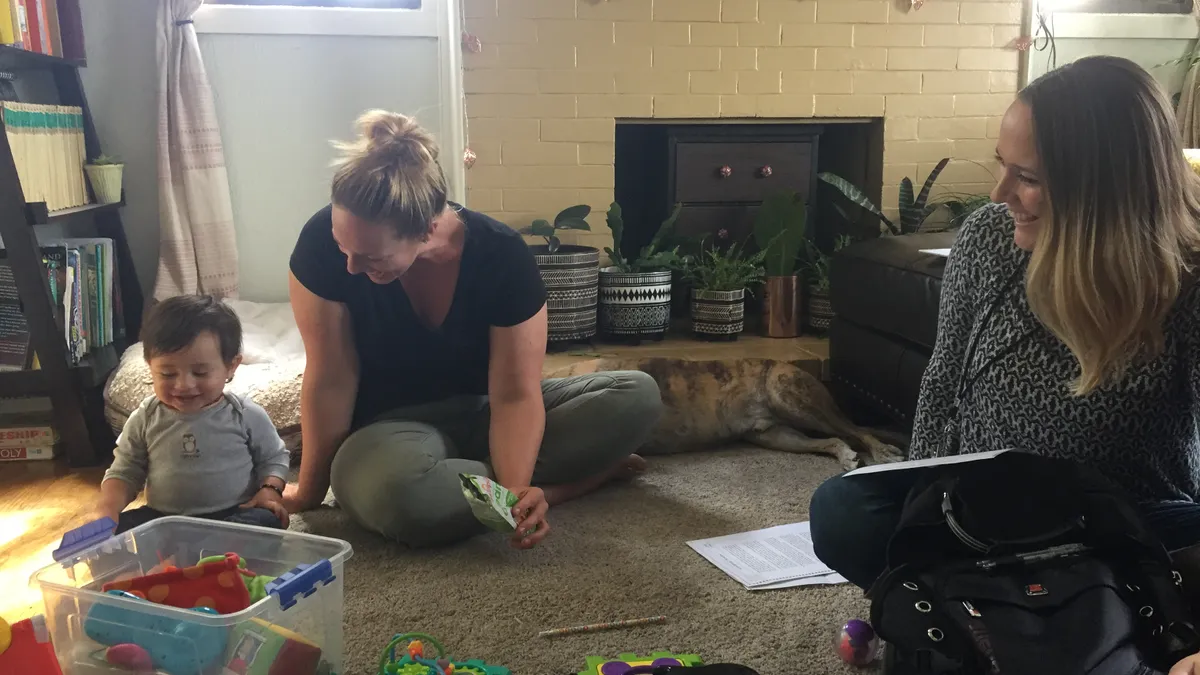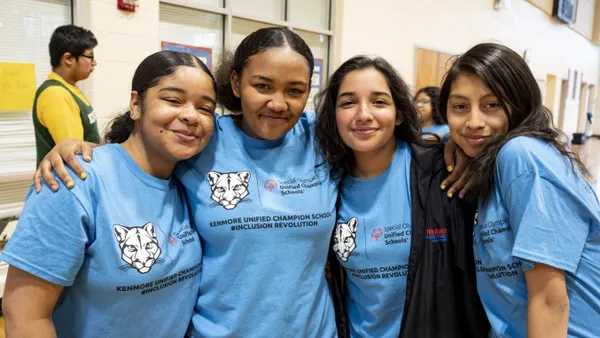This article is part of a series about First 5 — a tobacco tax initiative in California passed by voters 20 years ago to fund services for young children, from birth to kindergarten age. The series is supported by a University of Southern California 2018 Center for Health Journalism fellowship.
The potted plants in Julia Coke’s cozy living room are a reminder of when she worked in landscaping. But now her days are occupied with keeping 1-year-old Luca, who crawls on one knee, from playing with the leaves or trying to put them in his mouth.
Learning how to set limits as a mom has become a more frequent topic of conversation during her sessions with Justine Wiley, the Nurse-Family Partnership (NFP) home visitor who arrives at the Watsonville, California, Spanish-style bungalow every few weeks with a backpack of toys and answers to Coke’s questions.
“I really like how I get to direct what I want to learn about,” says Coke, as she and Wiley sit on the floor with Luca and his toys and discuss topics ranging from the right-sized car seat to giving toddlers choices in order to avoid battles over diaper changing or sitting in a high chair.
As the NFP model requires, Wiley — a registered nurse with the County of Santa Cruz Health Services Agency — began visiting Coke before Luca was born and remembers when Coke was a bit overwhelmed by all the advice and resources aimed at lower-income, first-time moms.
“Everyone wants to tell you how to do it,” Coke says. But today she and Wiley celebrate Luca turning one and the fact that Coke has accomplished the goals she set at their last visit.
Not all of Wiley’s encounters with her clients, however, are as pleasant as this one. Many of the moms she works with have far more complex needs. Some are housed in other people's garages and cooking on camp stoves. Some are living in shelters and don’t have supportive families.
“We have a lot of high-risk moms,” Wiley says. “Sometimes it’s hard to go into a home and deliver content when everything is hitting the fan.”
Building a ‘case statement’ for home visiting
If filmmaker Rob Reiner were to make a movie about First 5, he might choose Santa Cruz County for the setting. He would find that before his successful ballot initiative — Proposition 10 — created the system to improve the health and well-being of California’s young children 20 years ago, the coastal county had rates of child maltreatment that were above the state average.
When the proposition passed in 1998, there were 13.1 substantiated incidents of child abuse or neglect per 1,000 children in Santa Cruz County, compared to the statewide rate of 12, according to child welfare reports tracked by the University of California, Berkeley’s Center for Social Services Research and the Annie E. Casey Foundation’s long-running Kids Count project. By 2004, the county’s rate had increased to 16.2, compared to the state’s declining rate of 11.6.
Learning about that data through its strategic planning process, First 5 Santa Cruz County began funding Families Together, a home-visiting program led by social workers that meet with families, typically referred by child welfare agencies, as much as once a week.
“They are able to help that family support the development of their child,” David Brody, the executive director of First 5 Santa Cruz, said in an interview. The most recent data shows that during the 2016-17 fiscal year, the program served 175 parents or guardians with 186 children age 5 and under.
But First 5 Santa Cruz County has also worked to spread NFP, even though it’s run by a different agency, demonstrating how the organization — and First 5s in general — collaborate with other partners to increase services for at-risk families. An almost 40-year-old home-visiting program, NFP is backed by substantial research.
For young children, the results include reductions in language delays, child abuse and neglect, and behavioral and intellectual problems by age 6. A 15-year follow-up study, conducted in Elmira, New York, also showed that teens whose mothers had been part of the program were 59% less likely to be arrested.
A boost from marijuana taxes
Santa Cruz County’s new Thrive by Three initiative, which includes NFP, is also an example of how some counties have moved ahead in using marijuana tax revenue for children’s programs. While officials are still working out how to distribute statewide taxes on legalized marijuana sales, which voters approved in 2016, Santa Cruz County passed its own tax on marijuana manufacturers and cultivators and is directing some of those funds to expand NFP.
“We really helped build the case statement,” Brody said about working with the county’s health agency to use the new revenue source for home visiting. “We see home visitation as a core capacity that any community needs to have to provide support and care management navigation to families with young children.”
Across the state, many county First 5 commissions have supported different home-visiting models. In fact First 5 Los Angeles is the "largest funder of home visiting in the state," Executive Director Kim Belshé said in an interview. And while the agency, like other First 5s, have cut down on paying for programs because of declining tobacco tax revenues, this is an area where the Los Angeles commission is targeting significant funding — roughly $39 million in 2017, according to a report on home-visiting efforts in multiple agencies across the county.
"It is a direct service investment, but it is a direct service investment in the context of a broader policy and systems-change strategy both at the county level and statewide," Belshé said. "Home visiting in my judgment is the most important, initial investment in all of our families and children because we know learning begins before birth."
This year, the state legislature approved a $158.5 million, three-year pilot home-visiting program, beginning in fiscal year 2019, for families enrolled in California Work Opportunity and Responsibility to Kids (CalWORKs), the state’s public assistance program. County First 5s are among the agencies that can apply for the funds to implement the program.
First 5 San Joaquin is one of the county commissions that has applied. As with First 5 Los Angeles, the agency had already been collaborating with the county’s social services department to run a similar CalWORKs home-visiting program called Helping to Enhance Parents’ Potential, which provides up to four visits a month for as long as six months for families with young children. An evaluation showed that participants were more likely than nonparticipants to gain employment and stop receiving cash assistance. And after receiving the visits, they increased the number of books in the home and the number of days per week they read to their children.
The federal Maternal, Infant and Early-Childhood Home Visiting Program provides all states with funding for home visiting — almost $400 million per year — and several states, such as Oklahoma, Wisconsin and Virginia, also blend funds from a variety of sources to pay for home-visiting services. What's significant about California's new CalWORKs program — in part inspired by the work of First 5 — is that it's the first time the state "has invested state-controlled dollars in home-visiting programs," Barbara Gebhard, the assistant director of public policy for Zero to Three, an advocacy organization, said in an email.
Gebhard added that making the visits an ongoing feature of CalWORKs, allowing counties to serve families beyond first-time parents, and adding a $500 allowance for families to cover expenses such as car seats and baby-proofing supplies, are also significant aspects of the state's new initiative.
"We actually love it when schools want to partner with us."

Nicole Young
Licensed social worker and owner, Optimal Solutions Consulting
Partnering with schools
Home-visiting models, however, are expensive to implement. That’s why First 5 Santa Cruz County — which is experiencing a decline in its primary source of funding, tobacco taxes — has fully implemented the Positive Parenting Program as another strategy to reduce maltreatment.
Also called Triple P, the program is a tiered intervention model that begins with a basic level of resources, such as tip sheets and “pocket guides” on parenting teens or having a child with disabilities. Triple P practitioners also run one-time workshops on topics, ranging from preventing tantrums to helping with homework.
Families needing more support can receive brief, individualized coaching sessions, and those with more serious problems might be referred to ongoing coaching or participation in an eight- to nine-week Triple P group. The Triple P staff members also run sessions in partnership with schools.
“We actually love it when schools want to partner with us,” Nicole Young, a licensed social worker and the owner of a consulting organization that implements Triple P for First 5 Santa Cruz, said in an interview. “We have the content and they have the relationships with the families.”
Educators are also a source of referrals for NFP, and Wiley conducts many of her visits in schools, some of which have teen parent rooms or an on-site child care center. In fact, before she had her visit with Coke, her day began with a visit to Watsonville High School, where a former client greeted her with a hug, and told her she’s graduating next year and plans to go to college.
Young thinks one reason why Santa Cruz County had high levels of child maltreatment was because service providers used to pick and choose elements from a variety of intervention models, whether or not there was strong evaluation evidence to support them. But that has changed.
“I’ve seen in our county more awareness and acceptance of evidence-based programs,” she said.
Triple P, developed at the University of Queensland in Australia and used in multiple countries, has been found to have significant benefits. A 2009 stratified random assignment study conducted in South Carolina showed reductions in all three indicators measured — substantiated child maltreatment, foster care placements and hospitalizations or emergency room visits for injuries related to abuse or neglect.
“The results of this study demonstrate the feasibility and benefits of implementing a large-scale parenting intervention, using a population-based approach, to prevent [child maltreatment],” the researchers wrote.
But some experts have criticized the results, including a University of Cambridge criminology professor, who pointed to problems in the study's design and how the results were reported.
Even so, the program has spread to 40 states in the U.S. and at least 25 countries, and Brody said the program is a good complement to home visiting because it reaches everyone. “You can’t deploy home visitation for 50% of the population,” he says. “There’s no path to that.”
Since implementing the combination of approaches, Santa Cruz County has also seen a welcome decline in the number of child maltreatment cases. By 2015, the rate of substantiated reports of abuse and neglect per 1,000 children had declined to 6.7, and is now below the statewide level of 8.2.
‘The best job’
Wiley went into nursing because she wanted to specialize in maternal and child health. But after working in labor and delivery and seeing young mothers who “had no resources, were substance using, and there was no follow-up,” she looked for another avenue for providing services.
Now, “I think I have the best job in the world,” she said. “I get to watch moms and dads grow as parents and bond with their baby.”
Back at Coke's home, the mother thinks Luca is ready for a nap, she puts him in his bedroom and shuts the door. He cries for a few minutes, but is soon quiet — a milestone Coke reached a few months ago. Before they wrap up their visit and consult their calendars to schedule the next one, Coke talks about wanting to return to school and how she might afford child care.
On a NFP home visit form, Wiley jots down that she will look into whether Coke is eligible for Early Head Start and said she might want to spend the next session doing a “goal-setting activity.”
“We can talk about what you want your future to look like,” she told Coke. “I’ll try to make it not boring.”






















